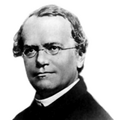Gene facts for kids
Genes are forms of DNA. DNA is a collection of chemical information that carries the instructions for making the proteins a cell will need. Each gene contains a single set of instructions. These instructions usually code for a particular protein. Humans have about 20,000 genes that code proteins and many more that are non-coding. Half of a person's genes come from the mother. The other half come from the father.
The definition
Originally: a hereditary unit which occupies a specific position (locus) on a chromosome. Other definitions are ways the gene showed itself:
- 1. A unit which has one or more specific effects on the phenotype of an organism;
- 2. A unit that can mutate to various alleles;
- 3. A unit which recombines with other such units.
Modern definitions must take note of later discoveries. There are now two classes of genes:p173
- 1. genes that are transcribed into RNAs and are translated into polypeptide chains.
- 2. genes whose transcripts (tRNAs, rRNAs, snRNAs) are used directly. These are operators which serve as 'regulatory sequences' during transcription and translation of the DNA.
What genes do
Genes are passed on from parent to child and are an important part of what decides how children look and act (their biological properties). Genes affect the way our bodies work, including how we look. Our eye, hair and skin color are decided by genes. It is said that genes cause genetic effects in our bodies.
A gene may be dominant or recessive. These terms refer to the effect a gene has on the offspring who carry it in their genome.
For example, let's say a mother only has genes for brown hair and a father only has genes for red hair. The child will inherit – receive – genes for red hair (from her father) and brown hair (from her mother). The brown hair gene is 'dominant' to the red hair gene. This means the child will have brown hair even though she has genes for both red and brown hair. This means only one dominant gene is needed for the child to receive that particular trait, while two recessive genes are needed for one.
A recessive trait might stay hidden for many generations. Let us use the child from the last example. We will call her "Mary". Mary has brown hair but has genes for both red and brown hair. Let us say Mary grew up and married Tom. Tom also has brown hair, but like Mary one of his parents had red hair. This means Tom has genes for both red and brown hair. Mary and Tom would each have a chance of passing either brown or red hair genes to their children. This means that the children of Mary and Tom could have either red or brown hair. This explains why a person might look different from their parents, but look like their grandparents or great grandparents.
Related pages
- Allele#Dominance
- Sequence analysis
- Genetics
- ENCODE, the complete analysis of the human genome
- Gene therapy
Images for kids
-
Fluorescent microscopy image of a human female karyotype, showing 23 pairs of chromosomes. The DNA is stained red, with regions rich in housekeeping genes further stained in green. The largest chromosomes are around 10 times the size of the smallest.
-
A sequence alignment, produced by ClustalO, of mammalian histone proteins
See also
 In Spanish: Gen para niños
In Spanish: Gen para niños


